Week 1: Starting the thesis process
- Present yourself
- Course info and practicalities
- Questionnaire
- Information about Slack study
- Fill out the topics table
An illustrated guide to a PhD (suits well also for MSc)
The research starts from an idea which then requires literature searches such that the researcher is able to develop an understanding of how this idea relates to existing research. Through the literature searches the idea may need to be elaborated to a more fresh and informed form as compared with the previous research. Finally, this leads to the formulation of an informed research topic, which is again followed by considerations on appropriate research strategy and design.
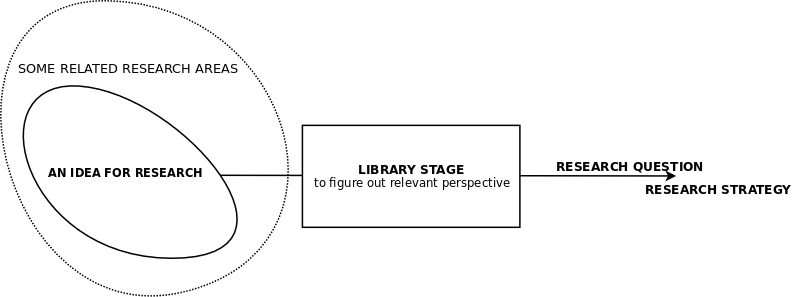 Research process according to Jenkins (1985)
Research process according to Jenkins (1985)
Finding a good research topic is one of the most difficult and the most important phase during your thesis work:
- Think about what you are interested of
- Personal interests?
- Company needs?
- Pre-given topics?
- Read about the topic and try to get the big picture
- Formulate questions, what you want to know
- Read more (keeping in mind your questions)
- Make questions more precise based on previous knowledge
In class task: freewriting
Freewriting is writing down your thoughts as they come to you. When freewriting, you let your sentences flow freely without thinking about whether the ideas are appropriate or the grammar is perfect. You just start writing. Write quickly and try not to stop. Usually, you freewrite on a topic for a set period of time or number of pages without rereading or correcting what you have written. You can freewrite with pen and paper or on the computer — do whichever comes more naturally to you.
Write one page text where you describe what you are going to do as master's thesis. This assignment is supposed to make you think about your topic and produce initial idea, what you are going to study.
- No references needed
- Describe the topic with your own words
- What do you already know about the topic
- What do you want to know about the topic
- How do you get data
- What is your timetable
In the beginning your text will always look like utter rubbish. Admit it, do not worry, that is just a start for something good.
Descriptive, normative and applied topics
Descriptive topics aims to find out how things are:
- I am working on the topic X
- because I want to find out how/why/whether Y (So what if you do?)
- so that I can help others understand how/why/whether
Normative topics aims to tell how things should be:
- I am working on the topic X
- because I want to find out how/why/whether Y (So what if you do?)
- so that I can tell readers what to do to fix/improve/decide
Existing scientific knowledge can also be applied to develop more practical applications, like technology or inventions.
Extra task 1:
In the class we were having some discussions how to start research process and how to find a topic. To compensate, I ask you write one A4 paper, where you try to answer the following questions:
- WHY did you choose the topic? What interests you about it? Do you have an opinion about the issues involved?
- WHO are the information providers on this topic? Who might publish information about it? Who is affected by the topic? Do you know of organizations or institutions affiliated with the topic?
- WHAT are the major questions for this topic? Is there a debate about the topic? Are there a range of issues and viewpoints to consider?
- WHERE is your topic important: at the local, national or international level? Are there specific places affected by the topic?
- WHEN is/was your topic important? Is it a current event or an historical issue? Do you want to compare your topic by time periods?
Reference: MIT Libraries
Weekly task 1: illustrating your topic
A thesis statement is a statement that tells you and your reader what you plan to write about. It is usually one sentence in the introduction to your paper. It tells the main idea of your paper. It might also give the reader an idea of the type of organization and the tone that you plan to use in your paper. Often a thesis statement is an answer to a question. Often it is a statement that you set out to prove.
Based on freewriting exercise, try to illustrate your thesis statement (main claim of your work) as a figure or diagram. Some examples here from the book Better Writing Right Now (Galko 2001, pp. 39-41):
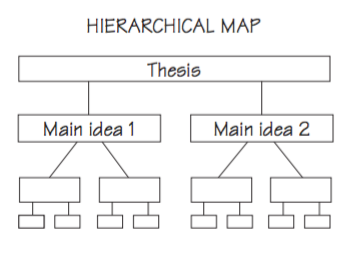
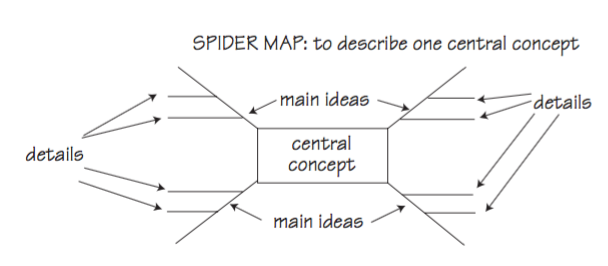
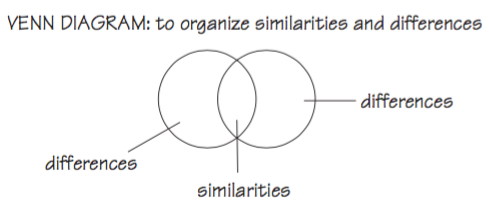
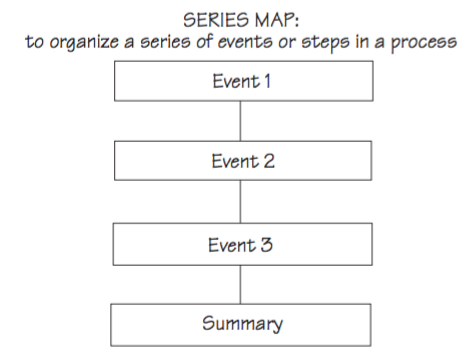

References:
- Galko, F. D. (2002). Better writing now: Using words to your advantage.
- Jenkins, A. M. (1985). Research methodologies and MIS research. Research methods in information systems, 103-117.
Week 2: research questions and introduction
Practicalities:
- New people?
- File formats when returning assignments
- Text documents = PDF
- Only pictures = PNG/JPG
- Naming policy for Slack: use first name (with first letter of surname)
- Do not use emails, I'm drowning anyway :)
- The 50% of the thesis must be done to get the credits (did not remember to mention in the last class)
Advices for the research topic
First and foremost - you should really start working on figuring out your topic, otherwise it is really difficult to take part to the seminar.
Lunenburg & Irby (2008) present in their Writing a successful thesis or dissertation that the criteria for a good topic are the following:
- Interest
- Significance
- Available data
- Knowledge and skills
- Manageability
How do you know the topic you selected is a good topic (Wang & Park, 2015)?
- Am I really interested in the topic?
- Am I familiar with the topic? If not, am I prepared to do extra research on it?
- Is there adequate information available to me to research this topic?
- Will I have access to my study population? Can I get permission to conduct this research?
- Does this topic offer future opportunities for research?
- Do I have personal experience related to this research topic?
- Will my future employment benefit from this research?
- Are there professors or tutors in my department who have expertise in this area? Will they be able to help me?
- Is my research topic not too broad and not too narrow?
- Is it feasible to do research on this topic within my time frame and with available resources?
Research questions
Four types of studies (Wang & Park, 2015):
- Exploratory studies examine newly emerging issues and inadequately known topics
- Descriptive studies provide information on the distribution of characteristics, behavioral patterns, attitudes, or opinions
- Explanatory studies address the "why" question - what is causing the particular issue or phenomenon
- Evaluative studies find out whether a social policy, intervention program or developed artefacts works or not
According to Wang and Park (2015) the research questions are:
- related to your literature reviews
- theoretical questions, which require data analysis to answer
- clear and specific
Drew (1980) identified three general categories of research questions: descriptive, relationship, and difference.
- Descriptive questions ask what some phenomena are like
- Relationship questions examine the degree to which two or more variables are related to each other
- Difference questions examine whether differences exist between or within individual groups or participants
Miles and Huberman (1994) present some examples how research questions can be divided to causal and non-causal questions. Even though the causal research is typical in natural sciences there are many dangers you should be aware of. Discuss, what is the difference between causality and correlation?
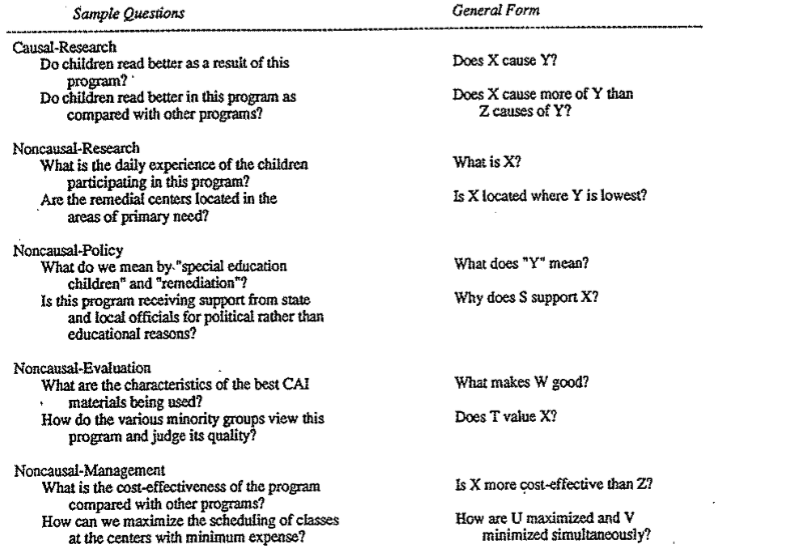
The process of formulating the research question evolves throughout the research process (e.g. Lodico, Spaulding & Voegtle 2010). Sometimes you figure out the final research questions when you analyse the data. In inclusive research that is really typical. Discuss, what does the inductive and deductive research mean in practice and is it really possible to categorize research in such way?
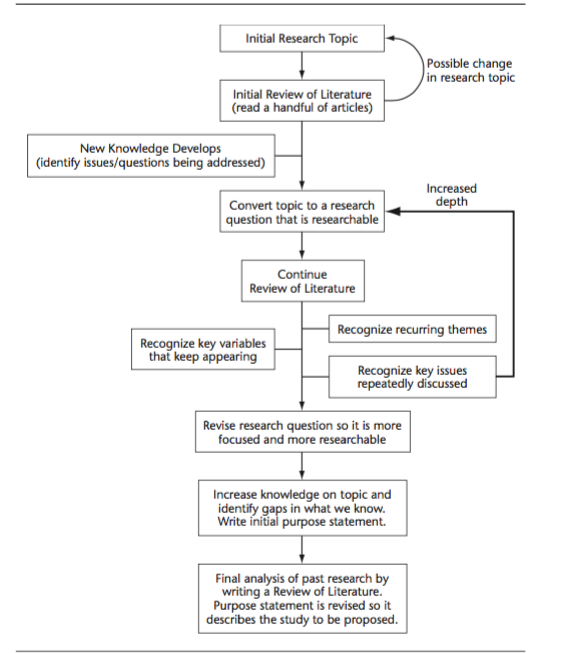
Erickson, Florio, and Buschman (1980) suggest that qualitative methods are best at seeking answers to questions like (from Borg & Gall, Educational research, 1989)
- What's happening in this field setting?
- What do the happenings mean to the people involved in them?
- What do people have to know in order to be able to do what they do in the setting?
- How does what is happening here relate to what is happening in the wider social context of this setting?
- How doea the organization of what is happening here differ from that found in other places and times?
Writing the initial introduction
A good practice is to start writing introduction immediately, because it is something where you describe other people what you are studying on. The final form of the introduction is normally written in the last phases of the research. After reading the introduction, reader should be able to know about following items in your research (according to Lunenburg & Irby, 2008):
- Background of the study:
- Identify the context within which your study will be conducted and give any background information needed to clarify the context.
- Tell the reader why the study is important.
- Build a case for the statement of the problem to follow.
- Highlight the key theoretical constructs you will describe in greater depth in theoretical chapters.
- Statement of the problem
- Definition of what you investigated in your study.
- A formal and succinct version of the process you went through in selecting and delimiting your topic
- Clarifies, outlines, limits, and brings into existence an expression of the problem you investigated.
- It answers the question of what is being done in the study.
- Problem usually evolves out of four circumstances
- Little or no research on a particular topic exists.
- There is some research, but it has not been applied to enough samples or in enough situations to be considered a reliable phenomenon.
- Research abounds, but the findings are contradictory.
- Two theories explain the same phenomena but recommend or predict different outcomes.
- Purpose of the Study
- How you plan to solve the problem defined previously.
- Significance of the Study
- Why is the study important or valuable?
- Will it revise, extend, or create new knowledge?
- Does it have theoretical or practical application?
- Definition of Terms
- Research Questions (or Hypotheses)
- Limitations and assumptions
- Organization of the Study
Introduction typically starts by telling about the background of study, describing the problem, stating the purpose of the study, and telling why the study is important. The final part of the introduction tells how the paper is organized.
Some high quality introductions from different MIT research orientations:
- Computers and Education (Elsevier): Laptop multitasking hinders classroom learning for both users and nearby peers
- International Journal of Human-Computer Studies (Elsevier): Gamification in theory and action: A survey
- ACM Transactions on Software Engineering and Methodology: Using Cohesion and Coupling for Software Remodularization: Is It Enough?
- ACM Transactions on Architecture and Code Optimization: Multi-Criteria Code Refactoring Using Search-Based Software Engineering: An Industrial Case Study
- ACM Transactions on Programming Languages and Systems: ThisType for Object-Oriented Languages: From Theory to Practice
Weekly task 2
First, write 1 page of initial introduction including background, problem statement, purpose and significance. In this phase the text might have bullets or single line paragraphs, but try to make the structure as a real intro.
Then, write down your initial research questions and add them to the end of the introduction. You can also describe the questions more precisely.
Extra task 2
Read the chapter 3: The Philosophy and Principles of Research from the book Research Methods in Politics (provided in Slack). Even though, the chapter is from the completely different discipline, it is concise and rather self-standing introduction for the topic.
Write one A4 paper, where you reflect how your own research is related with the concepts presented.
- What elements of the presented ontological views are related to your research?
- What causality means in your research?
- Is your research going to have inductive or deductive methodology?
References:
- Drew, C. F. (1980). Introduction to designing and conducting research (2d ed.). St. Louis, MO: C. V. Mosby.
- Lodico, M. G., Spaulding, D. T., & Voegtle, K. H. (2010). Methods in educational research: From theory to practice (Vol. 28). John Wiley & Sons.
- Lunenburg, Fred C., and Beverly J. Irby. (2008) Writing a successful thesis or dissertation: Tips and strategies for students in the social and behavioral sciences. Corwin press.
- Wang, G. T., & Park, K. (2015). Student Research and Report Writing: From Topic Selection to the Complete Paper. John Wiley & Sons.
Week 3: Finding, evaluating and managing references
Literature review is an essential part of any research. According to Lunenburg et al. (2008) the review of the literature can illuminate every aspect of a research problem by
- providing a historical background for it
- describing its current status,
- supporting the purpose of the study
- identifying gaps in the literature
- becoming aware of variables relevant to the problem
- understanding the seminal studies widely cited
- identifying the leading scholars relevant to the problem
- proposing useful theoretical constructs for the study
- understanding the application of appropriate methodological procedures
- observing comparative studies that assist in analyzing your data and interpreting the results
The process of literature review of Wang and Park (2015) is presented below. Real world the process is not so systematic, but includes all of these actions.
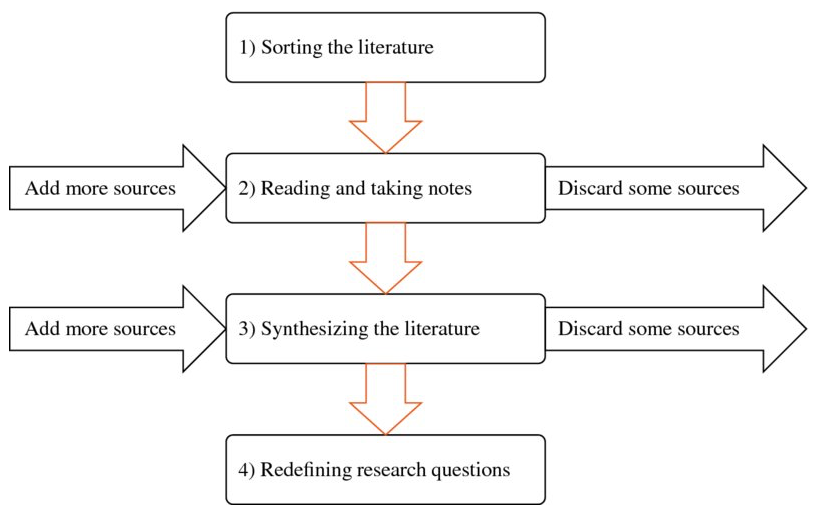
Class task: searching literature
- Group MOB
- Group OTE
- Group OPE/KT
- Group LT/SIMO
- Group PELMO
- Group WISE
Assignment:
- Find as many journals as possible related to your field (at least 4 journals) and make a list of them with name of the journal and a link to the journal's website
- Find as many conferences as possible related to your field (at least 3 conferences) and make a list of them with name of the conference and a link to the conference's website
- Compare the journal articles and conference articles - what are the differences in your opinion?
- What criteria there are to compare between journals (high quality vs. low quality)
- What criteria there are to compare between conferences (high quality vs. low quality)
- Develop a list of guidelines: how to evaluate, if a reference is good or not
The task is returned to Slack with private message to me and presented shortly in the class.
- Make a direct message to me
- Push plus button on the left of message input
- Choose "create a snippet"
- Write your answers as plain text
The results will be available on the seminar website next week (after the extra task's deadline). Remember to include member names. If you have any questions during the task, contact me in Slack or face to face.
Results
1. Journals:
- MOB
- EDU
- SE
- GAMING
2. Conferences:
- MOB
- EDU
- SE
- GAMING
3. Differences
- Conference papers might be short papers, workshop papers, and incomplete
- Conference articles may place emphasis on results and journal articles on theories, methodology etc.
- In general, peer review process is more strict and time consuming in journals
4. Characteristics of good journal
- Amount of citations
- Reliability of the journal website
- Relevant information is easily available
- Julkaisufoorumi
- Year of publication, newer is usually better (depends on context also, older might be better in some cases)
- Gaming articles can be informative and still not peer reviewed or scientifically approved
- Games in scientific context are still a new field. Research is scarce, but knowledge is somewhat there.
5. Characteristics of good conference
- Well-known editors or participants
- Reliable information on conference website
- Age of the conference
- Proceedings available
- How international the conference is
- English is the used language in conference
- Large number of peer reviewers is good
6. How to evaluate a reference
- Relevance to your research
- Quality of the journal or conference
- Is the author well-known
- Paper is peer-reviewed
- Quality of the references, certain publications appear often on the lists
- Amount of the citations ("cited by")
- When researching new subjects, evaluate the year of publication
Strategies for literature search
Research papers can be divided to primary, secondary and tertiary papers. Primary studies include literacy review to provide background for the research. Secondary studies are meta-analyses that review systematically primary studies to answer the presented research questions (e.g., what methods were used in programming related studies between 2010-2015). Tertiary studies review systematically secondary studies to, e.g., make recommendations for government policy or medical treatments.
Strategy 1: systematic literature review. Basically you define the search criteria, collect your data and go systematically through all the papers. Takes lots of time, because the aim is to go through the whole population of papers within the criteria. Smaller scale study would go through only predefined journals for certain time interval.
Strategy 2: keyword search. Define keywords, select databases, go through results and pick the papers matching your criteria. Keywords and selection criteria must be well defined to make the review valid.
Strategy 3: forward/backward search. Forward search means that when you find a good research article related to your topic. See what papers are referring to the article and read them. Backward search means that you see the bibliography of the article and start reading the references.
Strategy 4: "state of art" search. Define what are the main venues (journals/conferences) related to the topic. Go systematically through all the papers for 3-4 years and find out, what is the current state of art in the field.
Strategy 5: benchmarking search. Find the papers most relevant to your topic (same research problem / theory / method etc.) and look for examples, how to write about your study. This might be good idea to make in the beginning phase to see what kind of Master Theses have been written in your field. The drawback is that you might start unintentionally copying the other paper (or even plagiarizing).
Demonstration: reference management using Mendeley
Of course you can use any reference tool you want, but I am going to present a short demonstration, how I am used to work with Mendeley. Officially, University of Jyväskylä supports Refworks and it might be good idea to check it out
If you were not able to participate to the class, check out the video tutorials from here.
Weekly task 3: reviewing the literature
Find 6 - 10 research articles that are broadly related to your topic. You can use the results from the in-class task, make a new keyword search etc. Make a list of references (an example of bibliography below). Go through the papers and select 3 papers, which you examine more closely: read the papers, make notes and annotations. Write a short text where you argument why the chosen papers are important for your study (why is it a good reference).
Return the list of articles and the text with PDF. Mark to the list, which articles did you read and annotate.
P.S: it is good idea to use following convention in file names: weekly3_firstname_lastname.PDF
Next week we are going to look, how to write about literature so it is essential that you make this task.
Extra task 3
This one is simple, just do the in-class task from this week, but I assume you to elaborate a bit more to the questions 3, 4 and 5. All together, it should be 1-2 pages. Naturally, I recommend doing extra task before the weekly task.
P.S: it is good idea to use following convention in file names: extra3_firstname_lastname.PDF
References:
- Drew, C. F. (1980). Introduction to designing and conducting research (2d ed.). St. Louis, MO: C. V. Mosby.
- Lodico, M. G., Spaulding, D. T., & Voegtle, K. H. (2010). Methods in educational research: From theory to practice (Vol. 28). John Wiley & Sons.
- Lunenburg, Fred C., and Beverly J. Irby. (2008) Writing a successful thesis or dissertation: Tips and strategies for students in the social and behavioral sciences. Corwin press.
- Wang, G. T., & Park, K. (2015). Student Research and Report Writing: From Topic Selection to the Complete Paper. John Wiley & Sons.
Week 4: Writing about literature
Class task
Read the articles provided (title and abstract). Make a structure for the article, where you write headings for the theoretical chapters and couple of bullet points, what the content of the chapter could include. The outlines are made to chalkboard and discussed after.
Don't go and read the original thesis, because the idea is to discuss, what topics should be included in the literature review based on the abstract.
- Introduction
- Top level heading: should be in line with title
- Second level heading: more specific inside the topic
- Second level heading: more specific inside the topic
- Top level heading: should be in line with title
- Second level heading: more specific inside the topic
- Second level heading: more specific inside the topic
- Methodology
- Results
- Discussion
Master theses in Jyu:
- Lajitietokantaohjelman käyttäjälähtöinen suunnittelu biologian opetukseen:
- Fysikaalinen valaistus ja reaaliaikaiset heijastukset:
- Relaatio- ja epärelaatiotietokantojen suorituskykyvertailu: MySQL ja MongoDB
- Koirarotuja tunnistavan mobiilisovelluksen suunnittelu ja kiinnostavuus -tutkimus:
- Korkean käytettävyyden tekniikoiden hyödyntäminen tehohoidon ja anestesiologian tietojärjestelmissä:
Sorting literature (from Wang & Park, 2016)
Sorting the literature will help you better understand and summarize existing studies. It will also help you recognize trends, similarities, and differences among studies, which is the first step for organizing and synthesizing them. When you organize the literature by positive or negative findings, by theories, or by variables tested, you will understand the field of study in a systematic and organized manner. Seeing “the big picture” in this way will make the review process easier and more enjoyable.
Opposing arguments and findings: sorting articles by their points of view, such as pros and cons, or positive and negative findings. For example, some researchers find that the death penalty reduces violent crime while others find it has no effect on violence. Some researchers argue that some algorithm is better than the other one.
Different variables tested: sorting your literature according to specific relationships examined in the study. For example, ease of use and user acceptance.
Different theories applied: you may separate the papers into different groups according to the theoretical perspectives. In your review, you can evaluate how the perspectives may have led to different research foci and interpretation of findings. Typical example would be classifying educational research based on explicated educational theory.
Research methods: classifying your literature review according to the types of research methods that have been used. This is especially good method to find out, how your topic is being researched.
Time period: if you are interested in trends in research or social change, the literature can be classified according to the time of the research being conducted. You may put the books and articles into different groups according to the time period during which the research was conducted and published.
Population: you may also classify the literature according to the population you study. If the research on the same topic is conducted on different study populations such as different software applications / user interfaces / test procedures.
Synthesizing your literature
Successful literature review is a critical and organized assessment of existing studies. It should not merely list summary after summary but “evaluate, clarify and/or integrate the content of primary reports” (Cooper 1988: 103 as referred in Wang & Park, 2015).
Cooper (2010) emphasises the distinction between a narrative review and a synthesized review: A narrative review is a series of summaries of each article reviewed, typically in chronological order. Literature review is not a list of summaries presented in a paragraph or two for each study.
Heppner & Heppner (2004) propose that literature is organized so that more general information is discussed first, and the information most related to your thesis is discussed last.
 Literature funnel (Lunenberg et al., 2015)
Literature funnel (Lunenberg et al., 2015)
You can categorize your references as:
- Material that will be described in detail, because it is highly related to your study
- Material that will be briefly discussed
- Material that is related to your study, but too far away to discuss
A good literature review:
- Is a theoretical justification for your research
- Gives the knowledge background where your research aims to contribute
- Describes how your topic has been researched
- Aims to objectively evaluate what are the results of the previous research
- Explains why the chosen literature is relevant considering your research
- Defines the essential concepts
- Shows your knowledge about the topic
- Is presented with a clear focus
- Ends with your own research questions (not literally)
Responsible conduct of research
TENK: The responsible conduct of research
Weekly task 4
Make an initial outline of your study. Try to make descriptive headings for your content, you should have 1-3 main headings and 2-4 subheadings under them. Write 2-3 bullet points for under every subheading, what the content could be.
If you have already written content for your thesis, do not copy-paste the content to the outline. The purpose is to make good structure for your thesis without concentrating to the content (yet).
Return the PDF of outline to Slack as usual (with filename: weekly4_firstname_surname.pdf)
Extra task 4
Read Writing Integrative Literature Reviews: Guidelines and Examples by Richard J. Torraco. It is a decent paper, which discusses the same topics we had in the class. I also recommend it to students who even were in the class.
Find one literature review or meta-analysis paper related to your field. Usually good keywords for searches in scientific databases are "meta-analysis", "literature review" etc. combined with keywords related to your topic. Write A4 where you:
- Give the reference to the article
- What question the literature review tries to answer
- What did the literature review found out
References:
- Cooper, Harris. M. 2010. Research Synthesis and Meta-analysis: A Step by Step Approach. 4th ed. Thousand Oaks, CA: Sage.
- Lunenburg, Fred C., and Beverly J. Irby. (2008) Writing a successful thesis or dissertation: Tips and strategies for students in the social and behavioral sciences. Corwin press.
- Wang, G. T., & Park, K. (2015). Student Research and Report Writing: From Topic Selection to the Complete Paper. John Wiley & Sons.
Week 5: research approaches
Practicalities
We need to negotiate how we are going to organize the seminar presentations
- Korppi groups with enrollment
- I decide the groups and if the timetable is not ok, we are going to change
In the seminar you will present your research plan:
- Short background or motivation
- Research questions
- Method
- Your current state
- Timetable
There will be very strict timetable, so the presentations are short. After, there's feedback and review.
Framework of research approaches
Research approaches are plans and the procedures for research that span the steps from broad assumptions to detailed methods of data collection, analysis, and interpretation. Creswell (2014) explains how research approach belongs in the intersection of three components: philosophical worldviews, research designs, and research methods.
 Components of research approaches (Creswell, 2014)
Components of research approaches (Creswell, 2014)
Philosophical worldviews
Creswell sees worldviews as a general philosophical orientation about the world and the nature of research (aka. paradigms). He highlights four widely acknowledged worldviews discussed in scientific literature: postpositivism, constructivism, transformative, and pragmatism.
Post-positivism challenges the positivist notion of the absolute truth of knowledge and recognizes that we cannot be completely sure about our claims of knowledge, when studying the behavior and actions of humans. Post-positivism can be characterized as
- Deterministic philosophy in which causes (probably) determine effects and outcomes
- Postpositivists reflect the need to identify and assess the causes that influence outcomes, such as found in experiments
- Reductionistic in that the intent is to reduce the ideas into a small, discrete set to test, such as the variables that comprise hypotheses and research questions
- Knowledge development is based on careful observation and measurement of the objective reality that exists “out there” in the world
- There are laws or theories that govern the world, and these need to be tested or verified and refined so that we can understand the world
- Researcher begins with a theory, collects data that either supports or refutes the theory, and then makes necessary revisions and conducts additional tests
- Evidence established in research is always imperfect and fallible. Researchers do not prove a hypothesis; instead, they indicate a failure to reject the hypothesis (remember Popper?)
Social constructivism assumes that individuals seek understanding of the world in which they live and work. Individuals develop subjective meanings of their experiences. These meanings are varied and multiple, leading the researcher to look for the complexity of views rather than narrowing meanings into a few categories or ideas. The goal of the research is to rely as much as possible on the participants’ views of the situation being studied.
- Participants construct the meaning in discussions or interactions with other persons (thus social)
- Subjective meanings are negotiated socially and historically
- Researchers recognize how their backgrounds shape their interpretation
- Researcher aims to make sense of the meanings others have about the world
- Researchers inductively develop a theory or pattern of meaning
Transformative worldview holds that research inquiry needs to be intertwined with politics and a political change agenda to confront social oppression at whatever levels it occurs (Mertens, 2010).
- Research contains an action agenda for reform that may change lives of the participants, the institutions in which individuals work or live, and the researcher’s life
- Addresses issues like empowerment, inequality, oppression, domination, suppression, and alienation
- Researcher often begins with one of these issues as the focal point of the study
- Provides a voice for research participants, raising their consciousness or advancing an agenda for change to improve their lives
- Focuses on the needs of groups and individuals in our society that may be marginalized or disenfranchised
- Critical theorists; participatory action researchers; Marxists; feminists; racial and ethnic minorities; persons with disabilities; indigenous and postcolonial peoples; and members of the lesbian, gay, bisexual, transsexual, and queer communities.
Pragmatism arises out of actions, situations, and consequences rather than antecedent conditions.
- Not committed to any one system of philosophy and reality
- Truth is what works at the time: concerns with applications and solutions to problems
| Worldview | Ontological belief | Epistemological belief | Axiological belief | Methodological belief |
|---|---|---|---|---|
| Postpositivism | A single reality exists, but we may not be able to understand or get it | Knowledge is constructed through research and statistics | Bias needs to be controlled and not expressed in a study | Deductive methods, such as testing of theories, specifying variables, making comparisons |
| Social constructivism | Multiple realities are constructed through experiences and interactions | Knowledge is shaped by individual experiences (and researcher) | Individual values are honored and negotiated among individuals | Inductive methods, such as interviewing, observing, and text analysis |
| Transformative | Participation between researcher and communities | Knowledge is co-created | Values need to be problematized and interrogated | Collaborative processes, highlighting issues and concerns |
| Pragmatism | Reality is what is useful, practical, and works | Knowledge is generated through using both deductive and inductive tools | Knowledge reflects both the researchers' and participants' values | Both quantitative and qualitative methods |
Research designs
Researcher not only selects a qualitative, quantitative, or mixed methods study to conduct; the inquirer also decides on a type of study within these three choices. Research designs are called also as strategies of inquiry. Quantitative research design typically includes different kind of experiments, how a specific intervention influences an outcome, and survey research. Qualitative research design can have many different approaches: Narrative research studies the lives of individuals and asks one or more individuals to provide stories about their lives, phenomenological research describes the lived experiences of individuals about a phenomenon as described by participants, ethnography studies the shared patterns of behaviors, language, and actions of an intact cultural group in a natural setting over a prolonged period of time, and case studies are a design of inquiry found in many fields, especially evaluation, in which the researcher develops an in-depth analysis of a case, often a program, event, activity, process, or one or more individuals
Research methods
The third major element is the specific research methods that involve the forms of data collection, analysis, and interpretation that researchers propose for their studies. We are going to have an in-depth discussion of research methods next week.
Quantitative and qualitative research approaches
Historically the gap between quantitative and qualitative research approaches has been promoted by competing specialists. Traditional divergence of opinions is challenged by 'mixed methods'. Different research approaches should not be viewed as rigid, distinct categories, polar opposities, or dichotomies. Instead, they represent different ends on a continuum
Quantitative research is an approach for testing objective theories by examining the relationship among variables. These variables, in turn, can be measured, typically on instruments, so that numbered data can be analyzed using statistical procedures. Researchers who engage in this form of inquiry have assumptions about testing theories deductively, building in protections against bias, controlling for alternative explanations, and being able to generalize and replicate the findings.
Qualitative research is an approach for exploring and understanding the meaning individuals or groups ascribe to a social or human problem. The process of research involves emerging questions and procedures, data typically collected in the participant’s setting, data analysis inductively building from particulars to general themes, and the researcher making interpretations of the meaning of the data. Those who engage in this form of inquiry support a way of looking at research that honors an inductive style, a focus on individual meaning, and the importance of rendering the complexity of a situation.
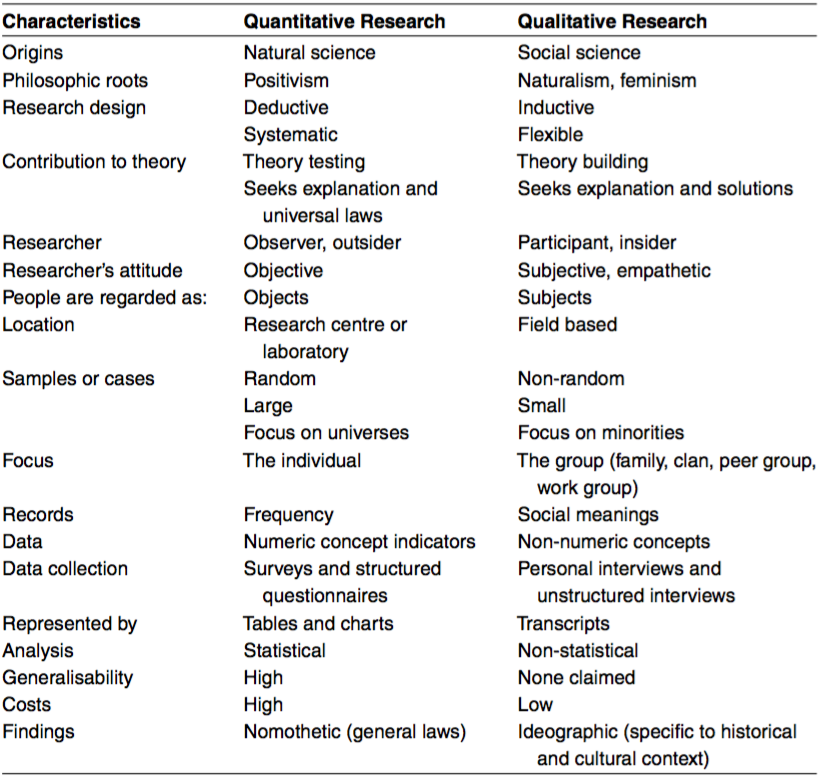 Characteristics of qualitative and quantitative methods (Pierce, 2008)
Characteristics of qualitative and quantitative methods (Pierce, 2008)
Quantitative
Strengths:
- General acceptance as being rational, logical, planned and systematic
- Regarded as being straightforward and providing the facts
- Researcher seen as inpassionate, objective and trustworthy
- Large samples designed to reflect and be presentative of the studied population
- Data gathering efficiency
- Effectively conforms to the modern-day business models
- Testing logical hypotheses (falsifibality)
- Means for identifying and comparing the distribution between people, places and times of phenomena
- Possibility to mine and analyse existing data banks (PISA as an example)
Criticism:
- The underlying doctrine of positivism is contestable in its application to the social world
- Too detached, remote and clinical to understand and explore the complex social world
- Use in social sciences does not meet the high standards of the natural sciences in which its reputation and claims lie
-
- Samples are not reliable enough
- Too many variables for causality ever to be determined
- Measures are fallible: what does it mean that X is three times more happy than Y
- How can abstract concepts, like happiness, be measured
- The reliance on observation limits the range and depth of research to what is both observable and measurable
Qualitative
Strengths:
- Best suited to understanding and explanation of the complexities of social life
- Unique capacity, through in-depth interviewing and observation, to learn and understand the underlying values of individuals and groups
- By learning the social meanings that the subjects apply to their world, researchers are better able to ‘see the world through the subject’s eyes’
- Enables the focus to be shifted from the individual to the group(s) and to learn how meanings are negotiated between members and the group dynamics involved
- Enables minorities to be researched who would otherwise be missed by sample surveys because they are either small in number or might be unwilling to identify themselves
- Sometimes the most interesting information hides behind the statistical presency
- Avoids distance and objectivity by seeking verstehen (empathetic understanding)
- Normative dimension: empowering subjects through the research process
- Offers a greater focus on verbal and other communications and the application of linguistics to the analysis
Criticism:
- The archetypal criticism is that the data collected is largely anecdotal or exaggerated
- Lacks the intellectual and operational rigor of quantitative method
- The claims to induction are spurious: the research question and concepts are influenced by prior research
- By participating with their subjects, the researcher will inevitably contaminate the social field and determine outcomes, or at least influence them in some way, rather than observe them
- Verstehen is elusive: how can a young, white, middle-class male researcher ‘see the world through the eyes’ of a female from a wholly different culture
- The researcher must interpret in turn the interpretation by the subject of their world and the scope for misinterpretation is huge
Weekly task 5: research methods
Next week we are going to make practical work related to research methods. Go through the resources provided below and choose one method which might suit to your study. Write 1-2 pages, how you would conduct your study with the chosen method.
- Sage research methods
- Mapping research methods
- KvaliMOTV: laadullisista menetelmistä suomeksi
- KvantiMOTV: määrällisistä menetelmistä suomeksi
Extra task 5: methodological paper
Find one scientific article (journal or conference) which aims to make a methodological contribution. It means that as a result of research, the authors are trying to develop existing or new methodology.
Write a short summary (1-2 pages), what the paper is about.
References:
- Creswell, J. W. (2013). Qualitative inquiry and research design: Choosing among five approaches. Sage.
- Mertens, D. M. (2010). Transformative Mixed Methods Research. Qualitative Inquiry, 16(6), 469–474. JOUR. http://doi.org/10.1177/1077800410364612
- Pierce, R. (2008). Research methods in politics. Sage.
Week 6: research methods in IT disciplines
The idea of the lesson is to figure out how different research methods can be used in computer science / mathematical information technology. The work will be done in groups of 2-3 human beings. Choose the method below or propose some other method.
Research methods in ICT discipline (student work)
- Action research
- Causal Analysis
- Classification method
- Correlation analysis
- Delphi method
- Descriptive statistics
- Factor analysis
- Grounded theory
- Grounded theory version 2
- Narrative analysis
- Network analysis
- Network analysis version 2
- Phenomenographical analysis
- Time series analysis
- Time series analysis version 2
Methods available:
- Conversation and interaction analysis (RESERVED)
- Phenomenological analysis
- Hermeneutic analysis
- Semiotic analysis
You can of course propose some other method for the weekly task.
Weekly task 6
The task is to write a description how the chosen method can be used in our discipline
1. method background
- what kind of topics the method is suitable in computer science / mathematical information technology
- Is the nature of the method deductive or inductive, or can it be both
- How is the method related with philosophical assumptions
- Can the method be fitted in Jarvinen's taxonomy of research methods
- Find an example article, where method is used. Give reference and DOI (or URL if not available)
- Is there any "founders" or "grandfathers" of the method? If is, who are they?
2. data collection
- Data collection methods
- What kind of data is typical for the method (numerical, media, text)
- What resources are needed for data collection
- How can technology be used in data collection
3. method implementation
write 1-2 pages text where you describe how the method was used in a fictional research. The related topic should be from our discipline.
- Who were the participants / what is the sample
- How were the participants / samples selected
- What kind of knowledge does the method produce
- In your opinion, how suitable is the method in our discipline
- How is reliability of the method assessed
- How is validity of the method assessed
- Is there any ethical issues that should be considered when implementing the method
Return the task as PDF file in Slack. Use filename "Weekly 6 research method.pdf" where research method is your chosen method.
Layout of the file is following:
- Title: name of the method
- 1st heading: background
- 2nd heading: data collection
- 3rd heading: implementation
- Write full paragraphs under the headings
- Use figures and tables if needed
- The paper will be available in the table presented here (if you don't want your name public, leave it out from the PDF text).
Extra task 6
Extra task this time is the same as weekly task. Choose one of the research methods which is not already selected or propose a new one.
Week 7: Writing Master's Thesis
The quality of text is one concrete item in the evaluation framework:


The quality of writing is actually much more - poorly written argument makes the author sound incompetent and, on the other hand, too complicated text makes the paper look like jargon. One aim of the thesis evaluation is to find out if the student is capable of understanding and producing the discipline related professional language.
Writing in general
Paraphrasing means writing the original information without changing the meaning. Effective paraphrasing is a key academic skill needed to avoid the risk of plagiarism: it demonstrates your understanding of a source. With paraphrasing you can use other people's ideas to validate your arguments and indicate that something is not your own idea.
Summarising aims to reduce the original information to a suitable length; to make conclusions about information.
Paragraph is a distinct section of a piece of writing, usually dealing with a single theme. The sentences of paragraphs in scientific text can usually be categorized to:
- Topic sentence
- Reason or explanation
- Example
- Argument (or supporting point)
- Conclusion
Task: analyse the following paragraph (from Bailey 2011, p. 78).
"The rate of home ownership varies widely across the developed world. Germany, for instance, has one of the lowest rates, at 42 per cent, while in Spain it is twice as high, 85 per cent. Both the USA and Britain have similar rates of about 69 per cent. The reasons for this variation appear to be more cultural and historic than economic, since high rates are found in both rich and poorer countries. There appears to be no conclusive link between national prosperity and the number of homeowners."
Cohesion of the text means the connectivity of ideas between sentences and paragraphs.
Coherence means if the text is making any sense.
Keep the paragraphs under the topic. This basically means that all of your paragraphs should be talking about the topic presented in the heading (or subheading).
Take distance to your text. It is much easier to review other text than your own, so it might be good to have few days pause and try to see your own text from other persons perspective.
Keep it short. The very typical problems of unclear writing are related to too long and complicated sentences or paragraphs.
Avoid "Finenglish". One difficult in writing a thesis in Finnish is that most of the references are in English, and translations can result to weak text quality.
"Yksi vaikeus kirjoittaessa opinnäytettä suomeksi on, että lähteet ovat englanniksi, ja käännökset voivat johtaa heikkoon tekstin laatuun."
"Opinnäytetyön kömpelö kieliasu voi johtua englanninkielisten lähteiden kääntämisestä suomeksi."
Use good dictionaries. When you find an unfamiliar concept, it is better to use English dictionary to understand it and the translate it to Finnish. Use e.g. Collins Dictionary or Ozdic.
Citations and references
For a technical guide, use e.g. the guide from Monash University. See APA or IEEE, because they are the most used citation styles in our disciplines. Consult your supervisor for the recommended citation style.
The following material is from a PhD course in 2016 by Adrienn Karoly: XENA004 - Academic Writing Module Citation and Referencing.
With citing and referencing you acknowledge the source of ideas that are not your own.
Citing in the text using round brackets in APA (author, date) or bracketed number [1] in IEEE.
Referencing by giving full publication details at the end of the text.
Bibliography means a list of all the works consulted in relation to the research (not necessarily cited). Do not use term "bibliography" in your thesis.
Citing and referencing is used to:
- to demonstrate academic integrity
- to recognize and honor others’ work
- to help put your work into context
- to validate your research
- to build on other people’s ideas to support your own voice, give weight to your arguments
- to help readers locate your sources
- to share knowledge, create a web of knowledge (your research extends this knowledge)
You have to use citations and references when:
- Quoting directly
- Summarizing or paraphrasing a theory/model/idea associated with a particular writer
- Emphasizing a particular theory/model/idea that has found a measure of agreement and support among several researchers
- Using visual data (tables, graphs, charts, figures, images, etc.)
It is not necessary to cite and reference when
- The information is general common knowledge - undisputed common facts (including historical facts), general descriptions of traditions or customs, and commonplace observations.
- The information is discipline-specific common knowledge - information which would be known by any researcher in your field of study, or which appears in all the textbooks on a given subject.
Plagiarism:
Weekly task 7: Thesis language review
If you missed the class, please go immediately to the extra task, because it is extended version of the weekly task. You only do extra task.
- Choose one Master's Thesis from JyX MIT theses list
- Write the reference in the beginning of the page (with URL)
- Choose one section or subsection (ideally about 2-3 pages) and use paraphrasing to explain what the section is about in one paragraph. Remember to use citation.
- Make a text analysis
- Choose one or two paragraphs and analyse the sentence structure
- What kind of transformative (moving from paragraph to another) techniques are used
- Analyse the cohesion of the section = how well does the content fit to the given heading
- Analyse if it is clear when the author is talking about own ideas and when paraphrasing
- Are the citations and references right
- Is there any linguistic errors
- One section should be self containing text which is understandable for a professional from the same field, even when not reading the whole paper. Does the text make sense as it is (coherence)
- Is the language objective or subjective
- Are the sentences or paragraphs complicated
- Return the task as PDF-file "weekly7_firstname_surname.pdf" to Slack before deadline
Extra task 7: extended version of Thesis language review
Choose two Master Theses from JyX MIT theses list. The first should be a Thesis that represents a well written paper and the other one badly written.
Make the text analysis presented in weekly task 7 and make a comparison of texts. What are the differences between good and worse texts? Provide examples (quotes).
Writing resources:
- Academic Phrasebank (can be applied in Finnish)
- The Purdue Online Writing Lab
- Study Guide - Birmingham City University
- Kirjoittajan ABC
References:
- Bailey, S. (2014). Academic writing: A handbook for international students. Routledge.
Week 8: end session
Getting the credits for the Thesis seminar:
- Make sure you have returned all the weekly tasks
- Make sure you have returned the possible extra tasks
- Do your presentation and the opponenting in the same session
- Ask your supervisor to inform me about the 50%
Thesis evaluation
In general, it is good idea to discuss beforehand with your supervisor what are your objectives and what degree you are aiming for. The links for evaluation forms:
- Evaluation guidelines in Finnish
- Evaluation guidelines in Finnish
- The evaluation form for MSc Thesis.
Maturity exam
Guidelines for the maturity exam based on Language Centre presentation:
- The text type is essay
- Thoughtful, critical, and reflective
- Not only lists, formulas, or figures
- Written in good and formal language
- Has coherent structure with beginning and end
- The essay must be independent -> reader should be able to understand the text without knowing the original Thesis
- The essay answers to the presented question in the exam
- Typical reasons for rejected maturity exam:
- Bad language (compound words, commas, sentence structures, etc.)
- Does not answer the proposed question
- No structure
- No introductory starting paragraph
- No conclusive ending paragraph
- The text is not understandable without reading the original Thesis
- Not analytical, critical, or reflective
The registration for the Maturity Exam is made to Outi Hynninen until 31.12.2016
In Finnish:
In English:
Seminar presentation
The presentation time is exactly 10 minutes. The aim is to practice scientific presentations in pre-given timetable.The presentation consists of four slides. The presentation slides need to be available in Slack #presentations channel as PDF two days before the presentation (so Saturday). The language of the presentation is Finnish or English. The outline of is following:
1st slide:
- Title: name of your work
- Author: your name
- Affiliation: MOB/EDU/CYBER etc.
2nd slide: background
- Short introduction -> you should make the audience understand your topic and domain with couple of sentences; e.g., WHAT: statement of the problem or WHY: purpose and significance of the study
- Research question(s)
- Key papers to your study (1-2). Just a short mention, you don't have time enough to explain them.
3rd slide: method
- What is your data / who are the participants?
- How do you collect your data?
- How do you analyse your data?
4th slide: progression
- What is the stage of your research? So what have you already done and what needs to be done?
- When the Thesis is done?
General advices for the presentation:
- Make your slides and practice at least one time your presentation
- Make sure you can keep up the timetable
- Choose your main points, less is more
- Your slides look well-structured and form an outline for your presentation
- Who is your audience and what implications it may have
- What is your venue and implications for your speech: compare "I am honored to present my topic..." and "I have to present my topic..."
- Think beforehand about the questions or critic the audience may present
- Having some nervous feelings is unavoidable and natural part of the presentation
Five classic presentation mistakes from the Thesis Whisperer blog:
- Too much information
- All theory, no action -> in our case, having too much about background and not enough about the empirical part
- Why are we here -> not stating clearly the purpose of your work
- Undigested text -> copy-pasting your text from Thesis draft to slides
- Question time = fail -> not preparing the possible questions
Opponenting
In addition to your own presentation you need to opponent the other presentations in the session:
Familiarize yourself with the another presentations using the provided slides in Slack and doing some background work about the topic.
Prepare at least one good question for every presentation beforehand. Stay focused during the presentation and think about questions and comments.
After the presentation I will randomly choose one person to ask the starting question. After that we will discuss about the topic and the other opponents are able to present their questions. After the discussion, the chosen person gives a short comment about the presentation in general.
Weekly task 8: review
Choose one Master Thesis from JyX MIT theses list. Can be the same one as in the previous extra task. Make a full review for the thesis using the guidelines provided in this session. Write 1-3 sentences argumentation for each category, why did you choose the degree. Returned as usual.
Extra task 8: scientific presentations
Find a recorded academic presentation or a scientific speech. You can try TED talks, Youtube etc. Provide the topic of the presentation and the URL for it in the beginning of the paper. Write 1-2 pages where you summarize the presentation and make analytical insight about the quality of the presentation.
Finally
Thank you everyone for participating the seminar, it has been an honor! Unfortunately, I am not able to give feedback about the weekly and extra tasks, but based on what I've read, you should have no problem with taming the Thesis and finishing your studies.
The course feedback and Slack questionnaire will be available at 11.12.2016, you will be notified with e-mail. I will really much appreciate for the feedback!
Good luck!